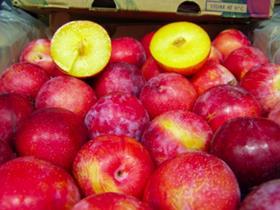
South Africa’s Stone Fruit Producers Association (SASPA) has warned growers over the potential impact on returns of exporting too many small specification plums during the current export season.
SASPA chairperson Pieter de Necker said in a statement that the early season, combined with a cooler spring and current warm growing conditions, had resulted in large volumes of smaller sized fruit with a relatively short harvesting window being harvested.
“At this stage it is anticipated that our largest export varieties, namely Leatitia and Songold, will be peaking on smaller sizes than expected which may cause further pressure on already tight market conditions,' explained De Necker. 'Concerns have been raised by several exporters regarding the larger quantities of smaller counts that has already been exported, which linked to the above, will have a negative impact on the remainder of the marketing season.”
He said that the plum harvest and export season was well underway, with the majority of early varieties having already been exported due to the season being 10-14 days earlier compared with last year.
“Early plum volumes, specifically Pioneer, African Rose and Sapphire, have not materialised as initially anticipated mainly due to smaller fruit size. Despite this, plum exports increased by 5 per cent during the early season,” he noted.
SASPA explained that growers and exporters were earlier in the season informed about the potential negative impact of smaller fruit sizes. It said that growers and exporters would have to liaise and strategise for the remainder of the season, given the fact that the traditional markets, namely the UK, Europe and Middle East, were already under pressure.
This is because there is generally more fruit available, particularly in the EU, due to the ban on EU exports to Russia.
Furthermore the general sales rate in the EU is slow. Large volumes of peaches and nectarines have also been shipped to the Middle East, hence a similar situation as in the EU exists there.
SASPA says competition from Chile is expected to increase this year with that country’s plum export crop set to be the largest in three years. Export volumes from Chile are expected to increase from 8.9m cartons last year to 24.3m cartons this year.
On the positive side, SASPA expects bigger sized fruit to be in short supply and should maintain a premium returns for growers. South Africa is also currently experiencing good growing conditions and the eating quality, sugar levels and colour of the country's stonefruit is very good. The Klein Karoo production area is also, relative to the rest of the Western Cape, at least seven days later which will help markets to clear stocks timeously.
De Necker called on growers and marketers to transparently discuss marketing plans and options for the remainder of the season, to act responsibly with the export of small fruit which should be aligned with fixed programmes and price indicators and to ensure that they are well informed about market conditions in order not end up shipping fruit at a loss.
Meanwhile, it is predicted that South Africa’s total stonefruit export volumes will reach more than 18.3m cartons this year.
Apricot exports, which already concluded the season, were a disappointing 20 per cent down on last year at 772,557 cartons, but this was more than made up for in peach and nectarine exports.
The nectarine export crop is predicted to be 24 per cent up on last year, at 3.6m cartons, and peaches increased by 19 per cent, to 1.9 million cartons. The plum crop is expected to be 7 per cent bigger than last year, at 11.3m cartons.



